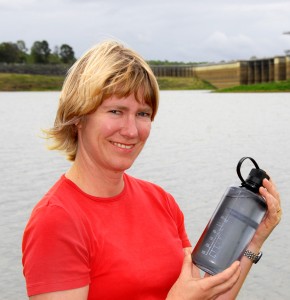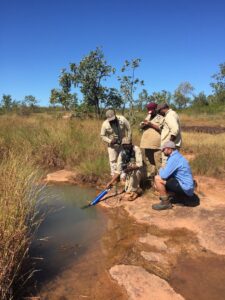The fact that the Gulf of Carpentaria region is seen as one of Australia’s iconic, pristine natural environments, full of wildlife and natural wonders, can lead to complacency when it comes to monitoring the health of these ecosystems over time.

A collaboration between Griffith University and the Carpentaria Land Council Aboriginal Corporation (CLCAC) is helping to overcome this complacency by training groups of Traditional owners to take the lead monitoring and safeguarding fresh & marine waterways in the Gulf of Carpentaria region.
Aquatic systems, such as wetlands, lakes, rivers and streams, groundwater seeps and estuaries can suffer from water quality problems, both natural and manmade, which impact drinking water supplies, and the animals and plants that live in these systems. There is also increasing pressure from water development, which can impact on waterway productivity and health.
Traditional owners have lived in northern Australia for tens of thousands of years and have a deep knowledge and connection to these aquatic systems, and a desire to protect them.
In the southern Gulf of Carpentaria lands, the CLCAC undertake ranger programs support the health of the lands and waters, which stretch from the lower Gilbert River to the Queensland/Northern Territory border, including the Wellesley Islands. Their program now includes water quality monitoring in both marine and freshwater lakes, wetlands, rivers and estuaries, thanks to a collaboration CLCAC initiated with Griffith University researchers.
This program involved identification of sites either of particular significance and/or where there is concern about water quality.
Professor Michele Burford from the Australian Rivers Institute, and Mr Stephen Faggotter from Griffith University’s School of the Environment and Science conducted training of water quality monitoring methods with CLCAC rangers.
“We developed a monitoring program tailored for each ranger group,” Professor Burford said.
“Currently, three ranger groups are now conducting their own regular monitoring of the region, with the training of one more group soon to begin.”

The water quality data collected is entered directly into a database while on site, making it quicker and easier to scan the data for quality control, and examine sites of particular concern.
This type of monitoring by traditional owners provides a means of looking at long term trends of related to factors that may affect water quality, such as agricultural development or climate change.
“Already monitoring by Griffith-trained traditional owners has revealed sites with high nutrient levels after large rain events in the wet season,” Professor Burford said. “High nutrient loads in waterways has the potential to cause algal blooms.”
“Through monitoring by traditional owners, we have also discovered sites with low dissolved oxygen levels late in the dry season as water levels drop, which can affect the ability of fish to breathe and may even lead to fish kills.”
The accumulating data the monitoring the health of fresh & marine waterways can be linked directly with attributes of particular significance and important habitats to traditional owners in this region.
For example, water quality can be linked with the sustainability of stocks of fish and crustacean species which are culturally important and/or provide a supplementary food supply for traditional owners in the region.
“It is hoped that this project will provide a starting point for a wider and ongoing collaboration to support environmental management in the unique Gulf country,” Professor Burford concluded.


